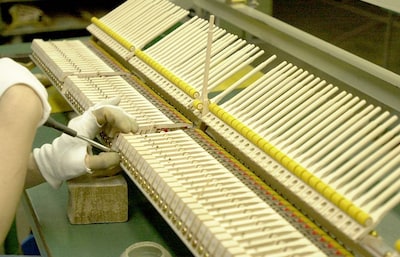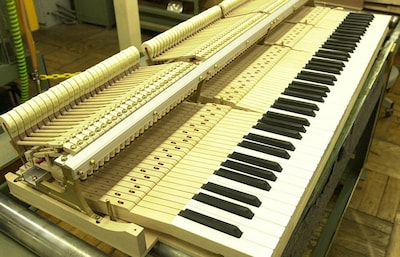Making the Keyboard and Action
The Keys Are Made from the Same Material as the Soundboard
This page describes the process of making the keyboard.
The same wood material used for the soundboard is used for the keys, such as Sitka spruce or Japanese spruce, which are virtually free from warpage.

The keys are finished to their final shape. The red parts in the center are felt-lined holes that fit over a small metal pin which protrudes from under the keys. If the keys are fitted too tightly, they will not move properly, and if the keys are fitted too weakly, they will rattle and movement will be jerky. Hence, the keys are adjusted so that they fall slowly when they are lifted up and released.
Precision to 5/100 of a Millimeter in the Action
The action is fabricated in a separate process.
The action is a complex mechanism composed of wood, metallic pins, felt, and other materials. If the linkages between the parts are too tight, they will stick and movement will be poor. If the linkages are too weak, the parts will rattle and movement will be jerky. Hence, the action must be finely adjusted. Lubricant is applied to the red felt parts to ensure smooth movement.
The action is made almost entirely from wood, and the standard for precision in cutting and milling is 5/100 of a millimeter.


Hammer Felt of 100% Wool
Next are the hammers, which are part of the action. First, white felt slabs made of pure wool are cut into triangular or trapezoidal shapes to match the model. The hammers gradually decrease in size as they move from the bass toward the treble range of the keyboard, and so the cross-sections are not uniform. They are left to rest for a short time to relax the fibers, then adhesive is applied and the felt is wrapped around a wooden core, completing the hammer.

Musical Instrument Guide : Piano Contents
Origins
Structure
How to Play
How the Instrument is Made
Choosing an Instrument
Care and Maintenance
Trivia
- The White Keys and Black Keys Were Reversed on Pianos in Mozart's Day
- Did Mozart's Piano Have a Pedal-Board?
- Piano with Automatic Accompaniment System in Beethoven's Day
- The Pianos Beloved by the Great Master, Sviatoslav Richter
- The Optimal Material for Piano Frames Is Also Ideal for Motorcycle Engines
- The Piano Soundboard Is a Board that Also Stops Vibrations
- Why Can't There Be More Than 88 Keys on a Piano?
- Why a Grand Piano Keyboard Feels Heavier Than an Upright Keyboard?


